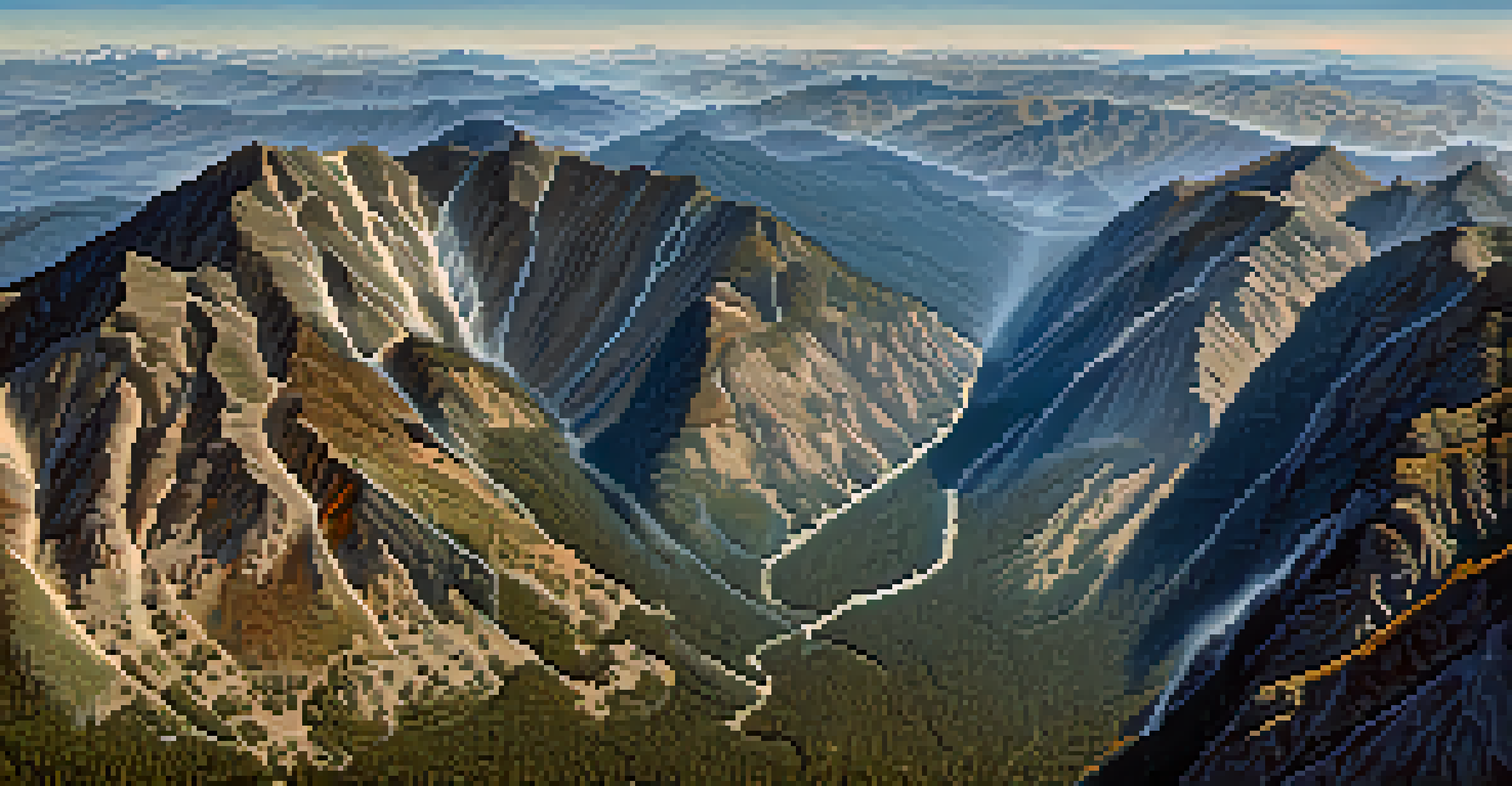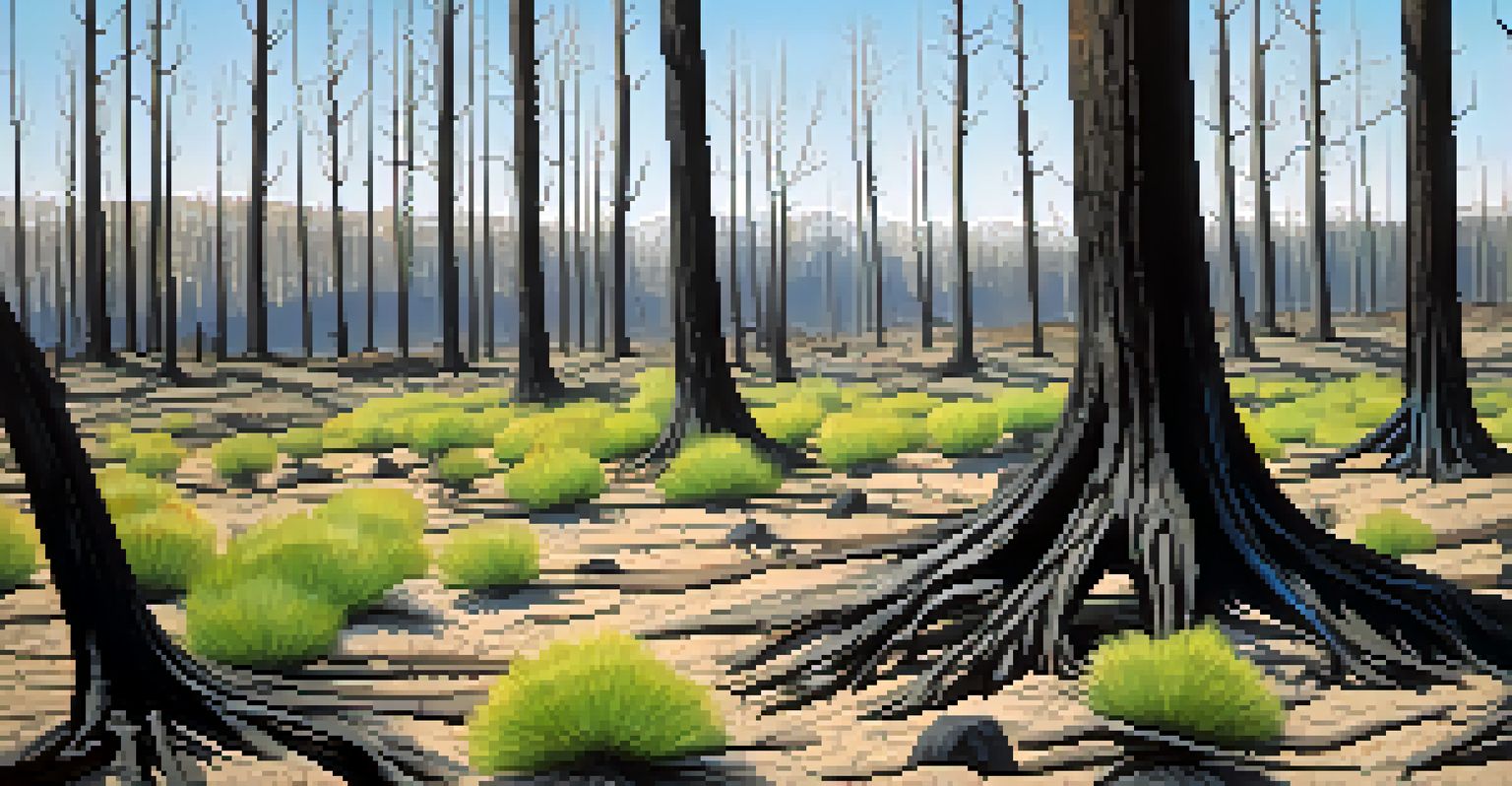The Impact of Wildfires on California's Geographic Features

Understanding California's Unique Geography
California boasts a diverse range of geographic features, from coastal cliffs to mountainous regions. This variety contributes to a rich ecosystem that supports numerous plant and animal species. However, the state's geography also makes it particularly vulnerable to wildfires, especially during dry seasons and in areas with dense vegetation.
Wildfires are a natural part of California's ecosystem, but their increasing frequency and intensity due to climate change poses a significant threat to both the environment and communities.
The interplay of climate, topography, and vegetation creates a perfect storm for fire outbreaks. For instance, the Sierra Nevada mountains, with their steep slopes and dense forests, can funnel winds and exacerbate fire spread. Understanding this unique geography is crucial for assessing the potential impact of wildfires.
Moreover, California's geography is continually evolving, and wildfires are a significant driver of these changes. The landscape itself can influence the fire's path, leading to both predictable and surprising outcomes in terms of what areas might be affected.
The Role of Climate Change in Wildfire Frequency
Climate change has made California's wildfire season longer and more intense. Rising temperatures and prolonged droughts create dry conditions that are ripe for wildfires. As a result, the frequency of wildfires has surged, leading to devastating impacts on both the land and the communities that inhabit it.

Studies show that warmer temperatures can lead to drier vegetation, which serves as fuel for fires. This cycle not only increases the likelihood of wildfires but also expands the areas that are at risk. Regions that were once considered safe are now facing unprecedented fire threats.
Wildfires Shape California's Landscape
California's unique geography and climate create conditions that make it susceptible to wildfires, impacting ecosystems and communities.
This shift in climate patterns not only affects current ecosystems but also alters how new ecosystems could develop in the future. The link between climate change and wildfire frequency is a critical aspect of understanding their impact on California's landscape.
Immediate Geographic Changes Post-Wildfire
After a wildfire, the immediate changes to California's geography can be striking. Burned areas often experience alterations in soil composition and vegetation coverage, which can lead to increased erosion. This erosion can reshape hillsides and riverbanks, changing the physical landscape significantly.
The resilience of our communities and ecosystems is tested every time a wildfire strikes, yet it also presents an opportunity for regeneration and recovery.
The loss of vegetation not only affects the visual aspect of the landscape but also impacts the local wildlife. Many animals lose their habitats, prompting migration to new areas, which can further disrupt ecological balances. The result is a landscape that looks vastly different than it did before the fire.
Additionally, the removal of vegetation can lead to increased runoff during rainstorms, raising the risk of flooding and landslides. These changes underscore the immediate and lasting impacts that wildfires have on California's geographic features.
Long-term Effects on California's Ecosystems
Wildfires can have both destructive and regenerative effects on California's ecosystems. While they can devastate flora and fauna, many ecosystems are adapted to fire and can regenerate over time. For example, certain species of trees, like the giant sequoia, rely on fire for their seeds to germinate.
However, the long-term impacts of repeated wildfires can lead to shifts in species composition. In some areas, invasive species may take root in place of native plants, which can alter the entire ecosystem's balance. This change affects not only plant life but also the animals that depend on those plants for food and shelter.
Climate Change Fuels Fire Frequency
Rising temperatures and prolonged droughts due to climate change have intensified California's wildfire season, increasing risks to previously safe areas.
Understanding these long-term effects is crucial for conservation efforts, as it helps identify which areas need protection and restoration. The resilience of California's ecosystems will be tested as wildfires continue to reshape the landscape.
Wildfires and Soil Health: A Complicated Relationship
The relationship between wildfires and soil health is complex and multifaceted. In the short term, wildfires can lead to nutrient-rich ash that enhances soil fertility. However, this benefit can be short-lived, as severe fires can also damage soil structure and reduce its ability to retain water.
Healthy soil plays a vital role in supporting plant life and maintaining ecosystems. The loss of soil health can lead to further erosion and hinder recovery efforts after a wildfire. This creates a cycle where the landscape struggles to rebound from the damage, impacting both the environment and local communities.
Understanding this relationship is essential for post-fire recovery strategies. By focusing on soil health, restoration projects can help ensure that the land can support life again, creating a more resilient landscape in the face of future wildfires.
Impact on Water Sources and Quality
Wildfires can have significant effects on California's water sources, impacting both availability and quality. When vegetation is burned away, the soil's ability to absorb water diminishes, leading to increased runoff. This runoff can carry ash, debris, and pollutants into nearby rivers and lakes, affecting water quality.
Moreover, the loss of forested areas can alter watershed dynamics, impacting the flow and storage of water. Areas that once relied on natural filtration through vegetation may see a rise in sedimentation, which can harm aquatic ecosystems. This change can disrupt the delicate balance of life in these water sources.
Community Recovery is Essential
The aftermath of wildfires profoundly affects communities, making recovery efforts vital for rebuilding lives and enhancing resilience.
Addressing the impact of wildfires on water quality is crucial for ensuring safe drinking water and maintaining healthy aquatic habitats. Effective management and restoration efforts can help mitigate these changes and protect California's vital water resources.
Community Impact and Recovery Efforts
The impact of wildfires extends beyond geography and ecosystems; it profoundly affects communities. Residents in wildfire-prone areas often face displacement, loss of property, and emotional trauma. Rebuilding after a fire can be a lengthy and challenging process, not only physically but also emotionally for those affected.
Community recovery efforts play a vital role in helping individuals and families rebuild their lives. Local governments and organizations often provide resources and support for affected residents, focusing on both immediate needs and long-term recovery strategies. Community engagement is essential in these efforts, as it fosters resilience and unity.

Ultimately, understanding the broader community impacts of wildfires can help inform policies and practices aimed at reducing risk and enhancing preparedness. As California continues to face the threat of wildfires, prioritizing community recovery will be essential for building a more resilient future.